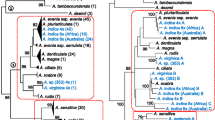Abstract
We analysed the genetic diversity of 270 Sinorhizobium meliloti strains isolated from nodules of three different Medicago sativa varieties, planted in three different Italian soils, combining the Analysis of Molecular Variance (AMOVA) with the Random Amplified Polymorphic DNA (RAPD) technique to estimate variance among RAPD patterns with the aim to draw an objective description of the population genetic structure. Results indicated that a general intraspecific genetic diversity was globally distributed among all the population, however a very high level of diversity was found among strains nodulating different Medicago sativa varieties. Moreover the distribution of the RAPD haplotypes among the plant varieties also showed to be non-random. The overall data indicated that the plant genotype is a major factor in shaping the genetic structure of this natural Rhizobium population.
Similar content being viewed by others
References
Bottomley PJ (1992) Ecology of Bradyrhizobiumand Rhizobium. In: G. Stacey, R. Burris and H. Evans (Eds) Biological Nitrogen Fixation (pp 293-348). Chapman and Hill, New York
Bottomley PJ, Cheng HH & Strain SR (1994) Genetic structure and symbiotic characteristics of a Bradyrhizobiumpopulation recovered from a pasture soil. Appl. Environ. Microbiol. 60: 1754-1761
Bromfield ESP, Sinha IB & Wolynetz MS (1986) Influence of location, host cultivar, and inoculation on the composition of naturalized populations of Rhizobium melilotiin Medicago sativanodules. Appl. Environ. Microbiol. 51: 1077-1084
Dalton H (1980) The cultivation of diazotrophic microorganisms. In: F. J. Bergersen (Ed) Methods for evaluating biological nitrogen fixation (pp 13-64). John Wiley & Sons, New York
Demezas DH, Reardon TB, Watson JM & Gibson AH (1991) Genetic diversity among Rhizobium leguminosarumbv. trifoliistrains revealed by allozyme and restriction fragment length polymorphism analyses. Appl. Environ. Microbiol. 57: 3489-3495
Demezas DH, Reardon TB, Strain SR, Watson JM & Gibson AH (1995) Diversity and genetic structure of a natural population of Rhizobium leguminosarumbv. trifoliiisolated from Trifolium subterraneumL. Mol. Ecol. 4: 209-220
Dykhuizen DE & Green L (1991) Recombination in Escherichia coliand the definition of biological species. J. Bacteriol. 173: 7257-7268
Eardly BD, Materon LA, Smith NH, Johnson DA, Rumbaugh MD & Selander RK (1990) Genetic structure of natural populations of the nitrogen-fixing bacterium Rhizobium meliloti. Appl. Environ. Microbiol. 56: 187-194
Eardly BD, Wang FS, Whittam TS & Selander RK (1995) Species limits in Rhizobiumpopulations that nodulate the common bean (Phaseolus vulgaris). Appl. Environ. Microbiol. 61: 507-512
Excoffier L, Smouse PE & Quattro JM (1992) Analysis of molecular variance inferred from metric distances among DNA haplotypes: application to human mitochondrial DNA restriction data. Genetics 131: 479-491
Grifoni A, Bazzicalupo M, Di Serio C, Fancelli S & Fani R (1995) Identification of Azospirillumstrains by restriction fragment length polymorphism of the 16S rDNA and of the histidine operon. FEMS Microbiol. Lett. 127: 85-91
Huff DR, Peakall R & Smouse PE (1993) RAPD variation and among natural populations of outcrossing buffalograss [Buchloë dactyloides(Nutt.) Engelm.]. Theor. Appl. Genet. 86: 927-934
Leung K, Yap K, Dashti N & Bottomley PJ (1994a) Serological and ecological characteristics of a noduledominant serotype from an indigenous soil population of Rhizobium leguminosarumbv. trifolii. Appl. Environ. Microbiol. 60: 408-415
Leung K, Strain SR, de Bruijn FJ & Bottomley PJ (1994b) Genotypic and phenotypic comparisons of chromosomal types within an indigenous soil population of Rhizobium leguminosarumbv. trifolii. Appl. Environ. Microbiol. 60: 416-426
Paffetti D, Scotti C., Gnocchi S., Fancelli S. & Bazzicalupo M. (1996) Genetic diversity of an Italian Rhizobium melilotipopulation from different Medicago sativavarieties. Appl. Environ. Microbiol. 62: 2279-2285
Piñero D, Martinez E & Selander RK (1988) Genetic diversity and relationships among isolates of Rhizobium leguminosarumbiovar phaseoli. Appl. Environ. Microbiol. 54: 2825-2832
Saitou N & Nei M (1987) The neighbor-joining method: a new method for reconstructing phylogenetic trees. Mol. Biol. Evol. 4: 406-425
Souza V, Nguyen TT, Hudson RR, Piñero D & Lenski R (1992) Hierarchical analysis of the linkage disequilibrium in Rhizobiumpopulations: evidence of sex? Proc. Natl. Acad. Sci. (USA) 89: 8389-8393
Strain SR, Leung K, Whittam TS, de Bruijn FJ & Bottomley PJ (1994) Genetic structure of Rhizobium leguminosarumbiovar trifoliiand viciaepopulations found in two Oregon soil under different plant communities. Appl. Environ. Microbiol. 60: 2772- 2778
Triplett EW & Sadowsky MJ (1992) Genetic of competion for nodulation of legumes. Annu. Rev. Microbiol. 46: 399-428
Whittam TS (1992) Sex in soil. Current Biology 2: 676-678
Author information
Authors and Affiliations
Rights and permissions
About this article
Cite this article
Paffetti, D., Daguin, F., Fancelli, S. et al. Influence of plant genotype on the selection of nodulating Sinorhizobium meliloti strains by Medicago sativa. Antonie Van Leeuwenhoek 73, 3–8 (1998). https://doi.org/10.1023/A:1000591719287
Issue Date:
DOI: https://doi.org/10.1023/A:1000591719287




